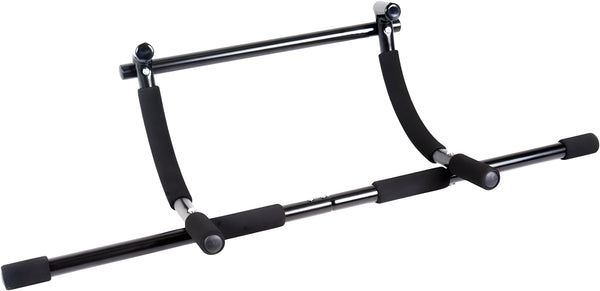Your Cart is Empty
February 20, 2023 3 min read
When it comes to fitness and strength training, pull-ups have been around for a long time. They are one of the most effective exercises for building upper body strength, conditioning your core muscles, and developing back muscles. Pull-ups can be done in many different ways, and when you structure your workouts correctly, you can maximize the benefits of this exercise.
Shop The Collection: Pull Up BarsThe key to structuring pull-up workouts for maximum benefit is to vary the intensity and volume of repetitions. You should also focus on proper form and technique as well as rest intervals between sets. This article will provide tips and advice on how to structure your pull-up workouts for maximum benefit.
 Shop The Gear: CAP Barbell Xtreme Doorway Pull Up Bar, $27.99 USD
Shop The Gear: CAP Barbell Xtreme Doorway Pull Up Bar, $27.99 USD
The first step in structuring your pull-up workouts for maximum benefit is to choose the right variation of the exercise. There are several variations of pull-ups that can target different muscle groups. Some of the most common types include narrow grip chin-ups, wide grip pull-ups, underhand grip pull-ups, and mixed grip pull-ups.
Narrow grip chin-ups are a great way to target your biceps and build overall upper body strength. Wide grip pull-ups are an excellent way to target your lats and build your back muscles. Underhand grip pull-ups will help strengthen your forearms and improve your grip strength. Mixed grip pull-ups are a great way to incorporate all these variations into one exercise.
Depending on your goals and fitness level, you can choose the right type of pull-up variation to ensure you get the most benefit from your workout.
In order to maximize the benefits of pull-ups, you should vary the intensity and volume of your workouts. Varying the intensity means adjusting the weight or resistance you use for each set. For example, if you’re doing wide grip pull-ups, you can start with a lighter weight and gradually increase it as you become stronger. This will help you build more muscle and strength.
Varying the volume means changing the number of repetitions you do for each set. For example, if you are doing three sets of pull-ups, you can vary the number of repetitions per set. Start with fewer reps and then gradually increase them as you become stronger. This will help you build more endurance and stamina.
Varying the intensity and volume of your workouts will help you get the most benefit from your pull-up workouts.
When performing pull-ups, it is essential to focus on proper form and technique. Doing pull-ups incorrectly can cause injury and reduce the effectiveness of the exercise. Make sure you keep your back and core muscles tight, your shoulders back, and your elbows tucked in. Also, make sure your wrists are straight and your palms facing away from you.
Focusing on proper form and technique will not only help you get the most out of your pull-up workouts, but it will also help prevent injuries.
It is important to take rest intervals between sets in order to give your muscles time to recover. The amount of rest you should take depends on the intensity and volume of your workout. If you are doing high intensity and volume workouts, then you should take longer rest intervals. If you are doing low intensity and volume workouts, then you should take shorter rest intervals.
Taking adequate rest intervals between sets will help you get the most out of your pull-up workouts and ensure that your muscles are properly recovered before your next set.
Pull-ups are one of the most effective exercises for building upper body strength, conditioning your core muscles, and developing back muscles. In order to maximize the benefits of pull-ups, it is important to structure your workouts correctly. You should choose the right variation of the exercise, vary the intensity and volume of repetitions, focus on proper form and technique, and take adequate rest intervals between sets.
By following these tips and advice, you can structure your pull-up workouts for maximum benefit and get the most out of your workouts.
Shipping Protection gives you peace of mind while saving you time and money.
Shipping Protection provides coverage for eligible orders that are lost or damaged in transit, or stolen after delivery has been confirmed by the carrier. MAGMA Fitness, through its partners, administers the protection program and may receive compensation for these services. Coverage is subject to the terms, conditions, and exclusions outlined in our Shipping Protection Terms & Conditions.